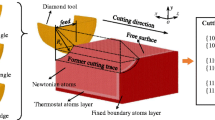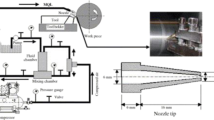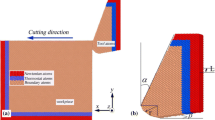Abstract
Three-dimensional molecular dynamics (MD) simulation was carried out to understand the mechanism of water lubrication in nanometric cutting. The water-lubricated cutting was compared with the dry cutting process in terms of lattice deformation, cutting force, heat and pressure distribution, and machined surface integrity. It was found that water molecules effectively reduce the friction between the tool and workpiece, the heat in the cutting zone and the pressure being generated on the tool surface, thus leading to prolonged tool life. Water molecules also enlarged the pressure-affected area, which decreased the roughness of the machined surface.
Similar content being viewed by others
References
De C L, Kunzmann H, Peggs G N, et al. Surfaces in precision engineering, microengineering and nanotechnology. CIRP Ann Manuf Technol, 2003, 52: 561–577
Yan J, Syoji K, Tamaki J. Some observation on the wear of diamond tools in ultra-precision cutting of single-crystal silicon. Wear, 2003, 255: 1380–1387
Komanduri R, Raff L M. A review on the molecular dynamics simulation of machining at the atomic scale. P IMechE, Part B, 2001, 215: 1639–1643
Zarudi I, Zhang L C, Swain M V. Effect of water on the mechanical response of monocrystalline silicon to repeated micro-indentation. Key Eng Mater, 2003, 233: 609–614
Tang C Y, Zhang L C. A molecular dynamics analysis of the mechanical effect of water on the deformation of silicon monocrystals subjected to nano-indentation. Nanotechnology, 2005, 16: 15–20
Chen R L, Liang M, Luo J B. Comparison of surface damage under dry and wet impact: Molecular dynamics simulation. Appl Surf Sci, 2011, 258: 1756–1761
Rentsch R, Inasaki I. Effects of fluids on the surface generation in material removal processes-molecular dynamics simulation. CIRP Ann Manuf Technol, 2006, 55: 601–604
Plimpton S, Fast parallel algorithms for short-range molecular dynamics. J Comp Phys, 1995, 117: 1–19
Humphrey W, Dalke A, Schulten K. VMD-visual molecular dynamics. J Molec Graphics, 1995, 14: 33–38
Li J. Modelling simulation. Mater Sci Eng, 2003, 11: 173–179
Nose S. A unified formulation of the constant temperature molecular-dynamics methods. J Chem Phys, 1984, 81: 511–519
Daw M S, Baskes M. Embedded-atom method: Derivation and application to impurities, surfaces, and other defects in metals. Phys Rev B, 1984, 29: 6443–6453
Morse P M. Diatomic molecules according to the wave mechanics. II. Vibrational levels. Phys Rev, 1929, 34: 57–64
Jorgensen W L, Chandrasekhar J, Madura J D, et al. Comparison of simple potential functions for simulating liquid water. J Chem Phys, 1983, 79: 926–935
Rapaport D C. The Art of Molecular Dynamics Simulation. Cambridge: Cambridge Univ Press, 1995
Leach A R. Molecular modelling harlow. Prentice-hall, 2001. 25–27
Hijazi A, Khater A. Brownian dynamics simulations of rigid rod-like macromolecular particles flowing in bounded channels. Comp Mater Sci, 2001, 22: 279–290
Guo Y B, Liang Y C, Chen M J. Molecular dynamics simulations of thermal effects in nanometri ccutting process. Sci China Tech Sci, 2010, 53: 870–874
Ye Y Y, Biswas R, Morris J R. Molecular dynamics simulation of the nano-scale machining of copper. Nanotechnology, 2003, 14: 390–394
Born M, Huang K. Dynamical Theory of Crystal Lattices. Clarendon: Oxford, 1954. 71–79
Fang F Z, Wu H, Zhou W, et al. A study on mechanism of nano-cutting single crystal silicon. J Mater Process Tech, 2007, 184: 407–210
Fang F Z, Venkatesh V C. Diamond cutting of silicon with nanometric finish. CIRP Ann Manuf Technol, 1998, 47: 45–49
Heino P, Perondi L, Kaski K. Stacking-fault energy of copper from molecular-dynamics simulation. Phys Rev B, 1999, 60: 14625–14631
Author information
Authors and Affiliations
Corresponding author
Rights and permissions
About this article
Cite this article
Chen, Y., Han, H., Fang, F. et al. MD simulation of nanometric cutting of copper with and without water lubrication. Sci. China Technol. Sci. 57, 1154–1159 (2014). https://doi.org/10.1007/s11431-014-5519-z
Received:
Accepted:
Published:
Issue Date:
DOI: https://doi.org/10.1007/s11431-014-5519-z




